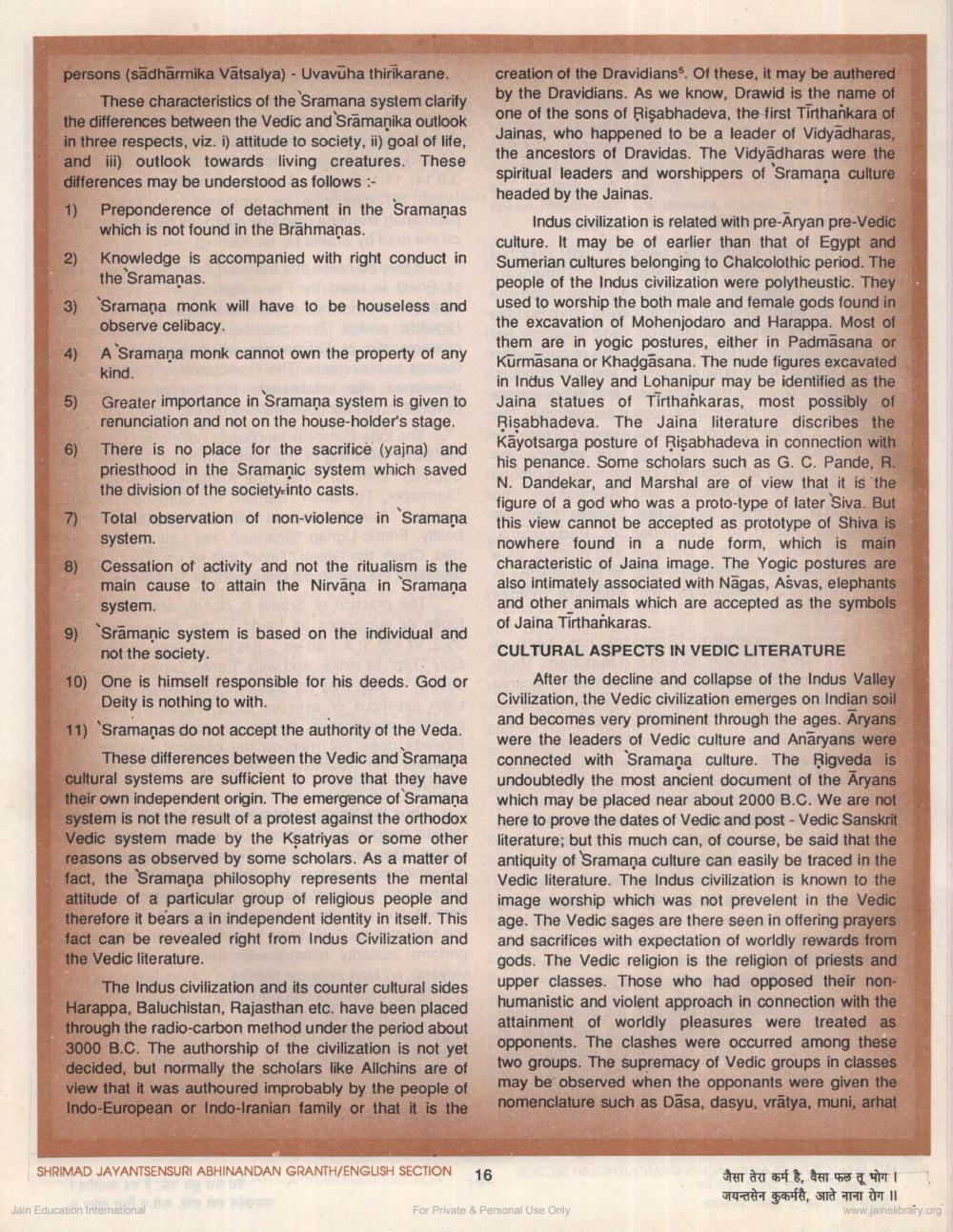Book Title: Antiquity or Jainism and tirthankara mahavir Author(s): Bhagchandra Jain Publisher: Z_Jayantsensuri_Abhinandan_Granth_012046.pdf View full book textPage 3
________________ 8) persons (sādhārmika Vātsalya) - Uvavüha thirikarane. These characteristics of the Sramana system clarify the differences between the Vedic and Sramanika outlook in three respects, viz. i) attitude to society, ii) goal of life, and iii) outlook towards living creatures. These differences may be understood as follows:1) Preponderence of detachment in the Sramanas which is not found in the Brāhmanas. 2) Knowledge is accompanied with right conduct in the Sramanas. 3) Sramana monk will have to be houseless and observe celibacy. 4) A Sramana monk cannot own the property of any kind. 5) Greater importance in Sramana system is given to renunciation and not on the house-holder's stage. 6) There is no place for the sacrifice (yajna) and priesthood in the Sramanic system which saved the division of the society-into casts. 7) Total observation of non-violence in 'Sramana system. Cessation of activity and not the ritualism is the main cause to attain the Nirvana in Sramana system. 9) Srāmanic system is based on the individual and not the society. 10) One is himself responsible for his deeds. God or Deity is nothing to with. 11) 'Sramaņas do not accept the authority of the Veda. These differences between the Vedic and Sramaņa cultural systems are sufficient to prove that they have their own independent origin. The emergence of Sramana system is not the result of a protest against the orthodox Vedic system made by the Ksatriyas or some other reasons as observed by some scholars. As a matter of fact, the Sramana philosophy represents the mental attitude of a particular group of religious people and therefore it bears a in independent identity in itself. This fact can be revealed right from Indus Civilization and the Vedic literature. The Indus civilization and its counter cultural sides Harappa, Baluchistan, Rajasthan etc. have been placed through the radio-carbon method under the period about 3000 B.C. The authorship of the civilization is not yet decided, but normally the scholars like Allchins are of view that it was authoured improbably by the people of Indo-European or Indo-Iranian family or that it is the creation of the Dravidians. Of these, it may be authered by the Dravidians. As we know, Drawid is the name of one of the sons of Risabhadeva, the first Tirthankara of Jainas, who happened to be a leader of Vidyadharas, the ancestors of Dravidas. The Vidyadharas were the spiritual leaders and worshippers of Sramana culture headed by the Jainas. Indus civilization is related with pre-Aryan pre-Vedic culture. It may be of earlier than that of Egypt and Sumerian cultures belonging to Chalcolothic period. The people of the Indus civilization were polytheustic. They used to worship the both male and female gods found in the excavation of Mohenjodaro and Harappa. Most of them are in yogic postures, either in Padmasana or Kūrmāsana or Khadgāsana. The nude figures excavated in Indus Valley and Lohanipur may be identified as the Jaina statues of Tirthankaras, most possibly of Risabhadeva. The Jaina literature discribes the Kāyotsarga posture of Rişabhadeva in connection with his penance. Some scholars such as G. C. Pande, R. N. Dandekar, and Marshal are of view that it is the figure of a god who was a proto-type of later Siva. But this view cannot be accepted as prototype of Shiva is nowhere found in a nude form, which is main characteristic of Jaina image. The Yogic postures are also intimately associated with Nāgas, Ašvas, elephants and other animals which are accepted as the symbols of Jaina Tirthankaras. CULTURAL ASPECTS IN VEDIC LITERATURE After the decline and collapse of the Indus Valley Civilization, the Vedic civilization emerges on Indian soil and becomes very prominent through the ages. Aryans were the leaders of Vedic culture and Anäryans were connected with Sramana culture. The Rigveda is undoubtedly the most ancient document of the Aryans which may be placed near about 2000 B.C. We are not here to prove the dates of Vedic and post - Vedic Sanskrit literature; but this much can, of course, be said that the antiquity of Sramana culture can easily be traced in the Vedic literature. The Indus civilization is known to the image worship which was not prevelent in the Vedic age. The Vedic sages are there seen in offering prayers and sacrifices with expectation of worldly rewards from gods. The Vedic religion is the religion of priests and upper classes. Those who had opposed their nonhumanistic and violent approach in connection with the attainment of worldly pleasures were treated as opponents. The clashes were occurred among these two groups. The supremacy of Vedic groups in classes may be observed when the opponants were given the nomenclature such as Dasa, dasyu, vrátya, muni, arhat SHRIMAD JAYANTSENSURI ABHINANDAN GRANTH/ENGLISH SECTION 16 जैसा तेरा कर्म है, वैसा फल तू भोग। जयन्तसेन कुकर्मस, आते नाना रोग ।। www.jainelibrary.org Jain Education International For Private & Personal Use OnlyPage Navigation
1 2 3 4 5 6 7 8 9 10 11 12 13 14 15 16 17
